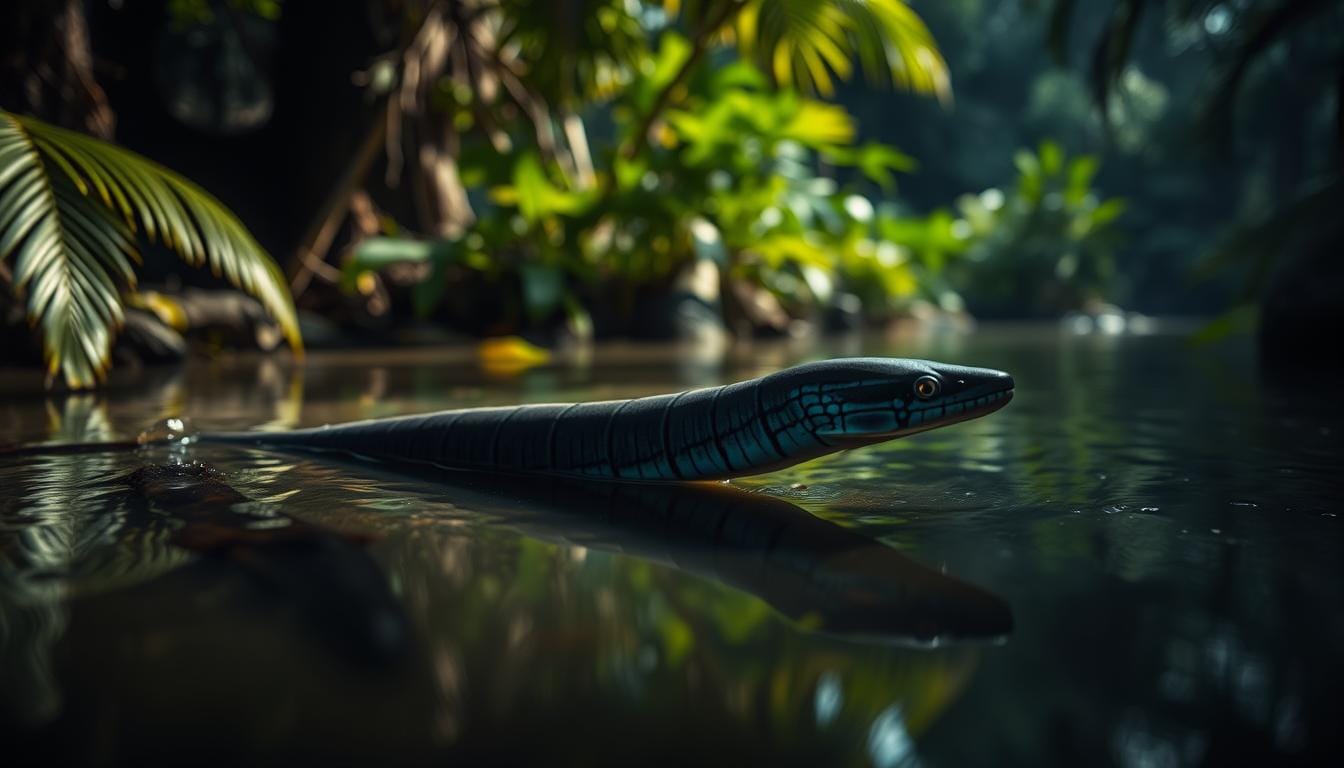The first time I saw an electric eel, my world changed. These amazing creatures are not just pets; they are living lightning rods. They challenge everything we know about owning exotic pets.
As someone who loves unique wildlife, I’ve learned a lot. An electric eel care guide is not just about keeping them clean. It’s about understanding a creature that can make electricity.
Electric eels are not actually eels but knife fish from South American rivers. They need special care and respect for their amazing abilities. Their electricity helps them defend and navigate, making them fascinating aquarium pets.
Dealing with electric eel care is complex. You need to know their special needs, what they eat, and the challenges they face. This guide will help you understand how to care for these unique pets.
Table of Contents
Understanding the Electric Eel Species
Electric eels are truly fascinating creatures that challenge our understanding of life in water. They are not true eels but belong to a unique group of electric fish found in South American rivers. These remarkable electric eel species have evolved extraordinary abilities that set them apart from other aquatic creatures.
The genus Electrophorus contains three distinct species of electric eels, each with remarkable electrical capabilities. Key electric eel facts reveal their incredible voltage production:
- E. electricus: Produces approximately 480 volts
- E. varii: Generates around 572 volts
- E. voltai: Capable of producing up to 860 volts
Physical Characteristics
These extraordinary creatures can grow up to 2.5 meters (8 feet) in length, with an average size of 1.8 meters. They possess three unique electric organs that enable their shocking capabilities:
- Hunter’s organ
- Sach’s organ
- Main electric organ
Natural Habitat and Range
Electric eels inhabit slow-moving rivers with poorly oxygenated water in the Amazon and Orinoco basins. Their environment requires specific conditions that make them challenging to maintain in captivity. They are known to form rare social groups called swarms, demonstrating complex behavioral patterns uncommon among fish species.
| Species | Max Voltage | Average Length |
|---|---|---|
| E. electricus | 480 volts | 1.8 meters |
| E. varii | 572 volts | 1.9 meters |
| E. voltai | 860 volts | 2.5 meters |
Understanding these unique electric eel species requires appreciating their complex biological adaptations and specific environmental needs.
Setting Up the Ideal Aquarium
Creating the perfect electric eel habitat needs careful planning and specialized knowledge. Your electric eel tank setup must be precise to ensure your exotic pet thrives. These remarkable creatures need a sophisticated environment that mimics their natural ecosystem.
Tank Size and Dimensions
Electric eels need a lot of space because of their impressive size. When planning your electric eel habitat, remember these key tank requirements:
- Minimum tank capacity: 250-300 gallons
- Length: At least 8-10 feet long
- Width: Minimum 3-4 feet wide
- Depth: 2-3 feet to accommodate natural swimming patterns
Water Conditions and Temperature
Maintaining optimal water parameters is crucial for your electric eel’s health. Your electric eel habitat should replicate South American river conditions:
- Water temperature: 75-82°F (24-28°C)
- pH level: 6.0-7.5
- Water hardness: Soft to moderate
- Recommend using reverse osmosis water for precision
Filtration and Aeration Systems
Powerful filtration is essential for your electric eel tank setup. These creatures produce significant waste and require robust water management:
- Use high-capacity canister filters
- Implement multiple filtration stages
- Ensure strong water circulation
- Install backup filtration systems
Pro tip: Always have a secure, electrical-resistant lid to prevent potential escapes!
Essential Diet for Electric Eels
Keeping an electric eel healthy means giving it the right food. These amazing creatures need a diet that matches their natural diet in the wild. They are carnivores and need lots of protein to stay healthy in captivity.
It’s important to know that electric eels are strict meat-eaters. They need a diet rich in protein to do well in captivity.
Recommended Foods for Electric Eels
Your electric eel’s diet should include:
- Live fish (primary food source)
- Frozen fish chunks
- Small crustaceans
- Prepared carnivore pellets
- Chopped seafood
“A diverse diet ensures optimal nutrition and mimics their natural hunting behaviors.”
Feeding Frequency and Amounts
Adult electric eels need to eat 2-3 times per week. Young ones might eat more often, about 4-5 times a week. Feed them 2-5% of their body weight each time.
Watch how much you feed them to avoid overfeeding. Remove any uneaten food right away. This keeps the water clean and prevents health problems.
Health Considerations for Your Electric Eel
Keeping your electric eel healthy is key to a long, happy life. Knowing about health issues is important for good care.
Electric eels need special care to avoid health problems. They are delicate and owners must watch for medical issues.
Common Health Challenges
Electric eels face several health issues:
- Parasitic infections that harm skin and internal organs
- Stress from changes in their environment
- Weak immune system from bad water quality
- Not getting enough nutrients from their food
Recognizing Signs of Stress or Illness
Spotting early signs can stop big health problems. Look out for these signs:
- Unusual swimming patterns
- Less electrical discharge
- Changes in eating habits
- Visible skin color changes or sores
“Prevention is always better than cure when caring for exotic aquatic species.” – Marine Biology Expert
Regular vet visits are crucial. Finding a vet who knows about electric eels is hard. But, taking care of your eel’s health keeps it happy for a long time.
Handling Your Electric Eel Safely
Electric eels are among the most challenging pets to handle. Their ability to shock makes them very dangerous. It’s important to be very careful and know a lot about them for safe interaction. Experts say it’s best to avoid touching them as much as possible.
When you’re around an electric eel, your main goal is to stay safe from their shock. These amazing animals can make up to 500 volts of electricity. This is very risky for people who handle them.
Critical Safety Precautions
- Always wear thick rubber electrical-resistant gloves
- Use non-conductive tools for tank maintenance
- Maintain minimal physical contact with the electric eel
- Keep electrical equipment away from the tank
- Never handle the electric eel without professional supervision
Recommended Handling Techniques
Experts suggest these methods for working with electric eels:
- Use long-handled nets with non-conductive materials
- Wear full-length protective clothing
- Maintain a safe distance during tank cleaning
- Work quickly and efficiently to minimize stress
- Have emergency medical resources nearby
Remember: An electric eel’s shocking power is a defense mechanism. Respect their natural capabilities and prioritize safety at all times.
Breeding Electric Eels in Captivity

Breeding electric eels in captivity is a tough task. These amazing animals have a very low success rate in breeding, with only about 5% of attempts working out.
To breed electric eels, you need to know a lot and control the environment closely. They need conditions that are very close to their natural home in the Amazon River basin.
Reproductive Behavior Insights
Electric eels have unique mating rituals. This makes breeding them very complex. Important factors for success include:
- Water temperature between 75°F to 82°F
- Precise pH levels of 6.0 to 7.5
- Adequate hiding spaces mimicking natural environments
- Minimal stress conditions
Caring for Electric Eel Fry
Looking after electric eel fry is a big challenge. They need special care, including:
- Carefully controlled water parameters
- Nutritionally balanced micro-diet
- Minimal human intervention
- Constant temperature monitoring
*”Electric eel breeding in captivity remains one of the most elusive challenges for marine biologists worldwide.”*
| Breeding Parameter | Recommended Conditions |
|---|---|
| Minimum Tank Size | 100 gallons |
| Breeding Success Rate | Less than 5% |
| Recommended Feeding | Live prey, varied diet |
| Typical Lifespan | 15-20 years |
Understanding electric eel breeding takes patience, expertise, and dedication. It’s a big commitment to these incredible animals.
Social Behavior and Compatibility
Electric eels are usually alone, which can be a challenge for those who keep them in aquariums. It’s important to understand their territorial behavior to keep them healthy.
Choosing tank mates for electric eels is very careful. Their strong electric shock makes it hard to find fish friends. The size of the electric eel also affects how it interacts with other fish.
Territorial Dynamics
Electric eels are very territorial, which means they don’t do well in community tanks. Their territorial behavior includes:
- Aggressive defense of personal space
- Potential to generate up to 860 volts of electrical discharge
- Preference for solitary living conditions
- Minimal tolerance for other fish in their habitat
Tank Mate Considerations
Electric eels are best kept by themselves. Trying to keep them with other fish can lead to:
- Potential injury to other tank inhabitants
- Increased stress for the electric eel
- Risk of unpredictable electrical discharges
- Disruption of natural behavioral patterns
For those who care for electric eels, creating a special environment is the best way to ensure their health and safety.
Providing Enrichment for Electric Eels

Creating a stimulating environment is key for electric eels in captivity. Knowing their natural habitat helps us design engaging spaces. These spaces should mimic their native ecosystem.
Designing Optimal Hiding Spots
Electric eels need lots of places to hide. Here are some tips for creating natural structures:
- Use driftwood and large rock formations
- Create dark, cave-like spaces
- Implement dense vegetation mimicking Amazon river environments
- Ensure multiple vertical and horizontal hiding zones
Interactive Enrichment Activities
Stimulating your electric eel’s natural behaviors is important. Creative enrichment techniques can prevent stress and keep their minds sharp:
- Introduce movable objects that simulate prey movement
- Rotate tank decorations periodically
- Use feeding puzzles that challenge hunting instincts
- Create variable water current patterns
| Enrichment Type | Purpose | Recommended Frequency |
|---|---|---|
| Habitat Complexity | Reduce stress | Permanent setup |
| Movement Stimulation | Encourage natural behaviors | Weekly |
| Feeding Challenges | Mental stimulation | 2-3 times per week |
Remember that each electric eel has unique preferences, so observe your pet’s responses and adjust enrichment strategies.
Understanding Electric Eel Behavior
Electric eels are amazing creatures with incredible electric powers. Their ability to shock is one of nature’s most interesting features. These fish use their electricity to hunt, navigate, and defend themselves in their home waters.
Electric eels have three specialized electrical organs that help them generate electricity. These organs – Hunter’s organ, Sach’s organ, and the main organ – work together to create powerful electrical discharges. The electric eel facts reveal they can produce up to 800 volts, making them among the most powerful electrical generators in the animal kingdom.
Electrogenesis Mechanism
The process of making electricity involves special cells called electrocytes. These cells act like tiny batteries, able to discharge electricity at the same time. When they are triggered, they create an electrical field that can:
- Stun prey for hunting
- Defend against potential predators
- Navigate murky waters through electrical signals
- Communicate with other electric eels
Typical Behavior Patterns
To understand electric eel behavior, we need to look at their unique traits. They live in slow-moving rivers and have interesting survival strategies. Their ability to shock allows them to jump out of the water and defend themselves, showing their amazing adaptability.
| Behavior | Description |
|---|---|
| Hunting | Use electrical pulses to locate and stun prey |
| Defense | Generate high-voltage shocks to deter predators |
| Surface Breathing | Rise to surface for oxygen in poorly oxygenated waters |
Electric eels show remarkable social behavior, sometimes working together despite being mostly solitary. Their electrical abilities make them one of the most unique and fascinating species in the water.
Legal Considerations and Regulations
Keeping an electric eel as a pet involves understanding complex laws. The rules for owning exotic pets vary a lot in the United States.
Before getting an electric eel, you need to know the laws that protect both the animal and its owners. Each state and local area has its own rules about owning exotic animals.
United States Ownership Laws
Not all states allow owning electric eels. Each state has its own laws, which can include:
- Strict permit requirements
- Mandatory veterinary documentation
- Specific housing and care standards
- Potential restrictions on interstate transportation
Permits and Documentation
To legally own an electric eel, you’ll need special documents. These might include:
- Exotic pet ownership license
- Proof of adequate housing facilities
- Health certificates for the animal
- Verification of legal acquisition source
Always check with local wildlife authorities and research detailed guidelines before buying an electric eel. This ensures you follow the laws in your area.
Resources for Further Learning
Learning more about electric eel care means finding trusted sources. Your journey to learn about these amazing creatures goes beyond this article. Many expert sources are ready to help you understand electric eels better. You can find detailed information on their behavior, habitats, and how to care for them.
Academic places and marine biology centers have lots of materials for you. The Smithsonian National Museum of Natural History and National Geographic have great research and guides. Journals like “Aquatic Sciences” and “Marine Biology” share the latest studies on exotic sea creatures.
Online forums like Exotic Pet Forums and Aquarium Hobbyist Networks are great for meeting other eel keepers. These places let you share tips, solve problems, and learn new care methods. Sites like AquaWorld and ExoticFishKeeping have boards where people share their experiences and advice.
Groups like the American Elasmobranch Society and the World Aquarium Association offer lots of learning resources. Their conferences, webinars, and publications are top places to learn about electric eel biology and care.

